



|
\({f_1}({\bf{x}}) = \left[ {\begin{array}{*{20}{c}}
\lambda & 0 \\
0 & \lambda \\
\end{array}} \right]{\bf{x}}\) |
scale by λ |
|
\({f_2}({\bf{x}}) = \left[ {\begin{array}{*{20}{c}}
\lambda & 0 \\
0 & \lambda \\
\end{array}} \right]{\bf{x}} + \left[ {\begin{array}{*{20}{c}}
{1 - \lambda } \\
0 \\
\end{array}} \right]\) |
scale by λ |
|
\({f_3}({\bf{x}}) = \left[ {\begin{array}{*{20}{c}}
\lambda & 0 \\
0 & \lambda \\
\end{array}} \right]{\bf{x}} + \left[ {\begin{array}{*{20}{c}}
{\dfrac{{1 - \lambda }}{2}} \\
{\dfrac{{(1 - \lambda ) \cdot \sqrt 3 }}{2}} \\
\end{array}} \right]\) |
scale by λ |
The attractor for the IFS consists of three overlapping pieces corresponding to the three functions in the iterated function system if λ is greater than 1/2.
If λ < 1/2, then the scaled triangles do not touch or overlap. The attractor is a self-similar fractal of dimension log(1/3)/log(λ).
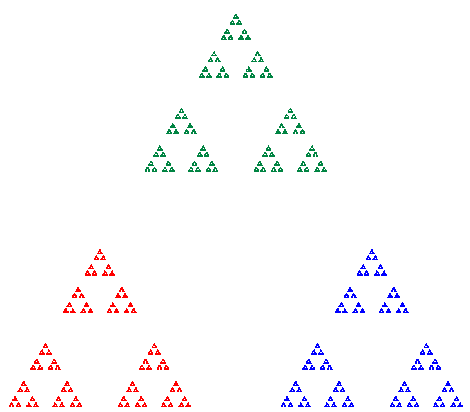
λ = 0.4
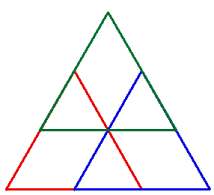 The figure to the right shows the first iteration when λ = 2/3. The three scaled triangles exactly fit together to fill the original equilateral triangle with no holes. Thus the union of the three (filled) triangles coincides with the original (filled) triangle and the attractor for the IFS will be that original (filled) triangle. If λ > 2/3, then the scaled triangles will overlap even more and the attractor will still be the original (filled) triangle.
The figure to the right shows the first iteration when λ = 2/3. The three scaled triangles exactly fit together to fill the original equilateral triangle with no holes. Thus the union of the three (filled) triangles coincides with the original (filled) triangle and the attractor for the IFS will be that original (filled) triangle. If λ > 2/3, then the scaled triangles will overlap even more and the attractor will still be the original (filled) triangle.
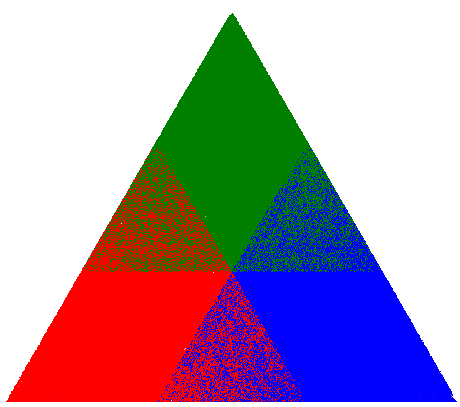
λ = 2/3
The first multinacci number w2 is the solution to \({x^2} + x = 1\), so \({w_2} = \dfrac{{\sqrt 5 - 1}}{2} = 0.618034\) is the reciprocal of the golden ratio. The figure below shows the attractor of the IFS for λ = w2.
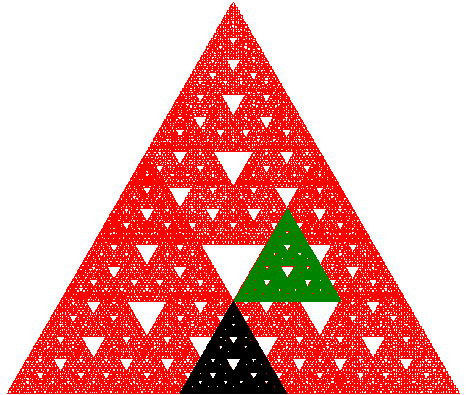
λ = w2 = 0.618034
In this image, the black region is \({f_2}({f_1}({f_1}({S_{{w_2}}})))\) where \(S_{w_2}\) is the fat Sierpinski gasket for λ = w2. The green region is \({f_3}({f_2}({f_1}({S_{{w_2}}})))\). In both cases, notice that the holes for the black and green regions line up with the holes in the attractor. To see why this might happen, consider the following illustration showing the first iteration with λ = w2.
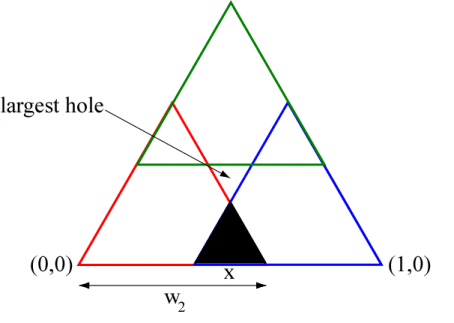
Observe that \(x = {w_2} - (1 - {w_2}) = 2{w_2} - 1\). Now \({w_2}^2 + {w_2} = 1\) and therefore
\[{w_2}^3 = {w_2} - {w_2}^2 = {w_2} - (1 - {w_2}) = 2{w_2} - 1 = x\]Notice also that the lower left vertex of the black triangle is at the same point as the blue triangle. What this all means is that if the original triangle is scaled three times by the factor w2 and translated to (1−w2,0), it will be in the same location as the black triangle. The same thing would happen in applying f1, f1, and f2 in succession to the attractor \(S_{w_2}\). A similar analysis can be done for the green triangle (which has also been scaled by w2 three times.)
The second multinacci number, w3, is the solution to \({x^3} + {x^2} + x = 1\), so
\[{w_3} = \frac{1}{3}{\left( {17 + 3\sqrt {33} } \right)^{1/3}} - \frac{2}{{3{{\left( {17 + 3\sqrt {33} } \right)}^{1/3}}}} - \frac{1}{3} = 0.543689\]The attractor for λ = w3 is shown below.
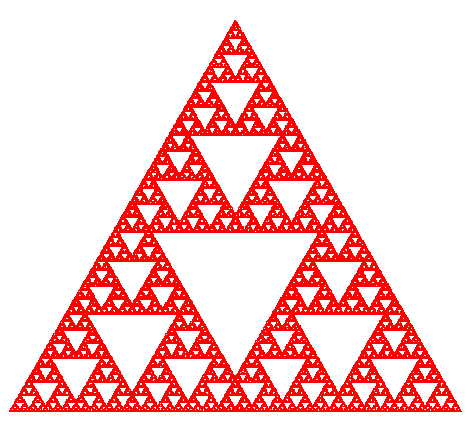
λ = w3 = 0.543689
Notice that it looks more like the Sierpinski gasket because w3 is closer to 1/2 than w2 is. (In fact, the multinacci numbers wm converge to 1/2 as m goes to infinity since in the limit, the left side of the equation satisfied by the multinacci numbers becomes a geometric series with sum \(\frac{x}{1-x}\) and that equation has the solution x = 1/2.) The attractor for w3 has the same total self-similarity property as for w2.
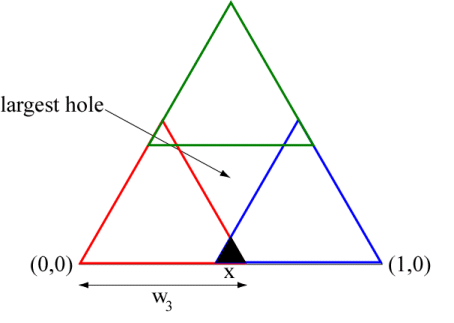
In this case the original triangle can been scaled by w3 four times and then translated to produce the black triangle where the red and blue triangles overlap. This is because \(x = {w_3} - (1 - {w_3}) = 2{w_3} - 1\) and \({w_3}^3 +{w_2}^2 + {w_2} = 1\) so that
\[{w_3}^4 = {w_3} - {w_3}^2 - {w_3}^3 = {w_3} - {w_3}^2 - (1 - {w_3} - {w_3}^2) = 2{w_3} - 1 = x\]
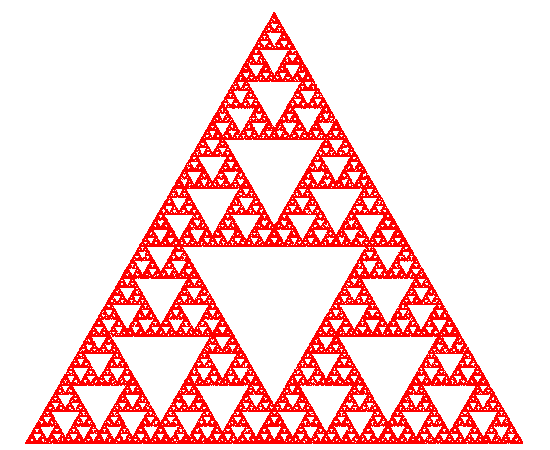
If λ is not one of the multinacci numbers, the holes for the three pieces f1(S), f2(S), and f3(S) do not line up. This can be seen in the following illustration of the fat Sierpinski triangle for λ = 0.58 (in red) with f1(S) superimposed on top (in green).
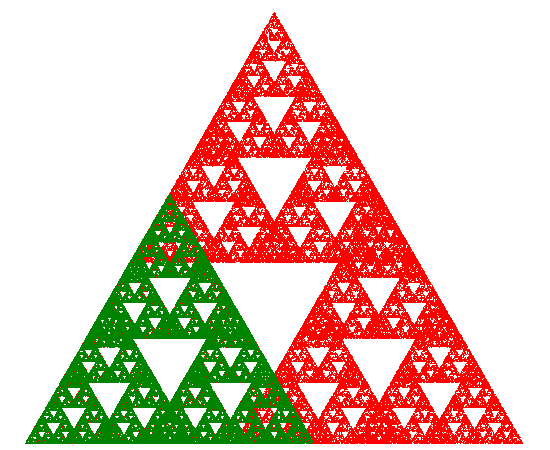
For m = 2 we have w2 = 0.618034 and τ2 = 0.394931 so dim(\({{S_{{w_2}}}}\)) = 1.930635.
For m = 3 we have w3 = 0.543689 and τ3 = 0.347999 so dim(\({{S_{{w_3}}}}\)) = 1.732184.
Broomhead, Montaldi and Sidorov also showed that the two-dimensional Lebesgue measure of \({{S_{{w_m}}}}\) is 0 for every m. This implies that these attractors have no interior.
It is known that for λ < \(1/\sqrt 3 \) ≈ 0.57735, the attractor Sλ has 0 Lebesgue measure. Thomas Jordan showed that for almost all λ in the interval \(\frac{1}{2} \le \lambda \le \frac{{\sqrt[3]{4}}}{3} \approx 0.5291\), the attractor Sλ has Hausdorff dimension equal to −log(3)/log(λ) and that for almost all λ ≥ 0.5853, the attractor Sλ has Hausdorff dimension 2. Donald Plante has extended some of these results in his 2012 Ph.D. thesis.